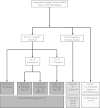Targeted genetic testing for familial hypercholesterolaemia using next generation sequencing: a population-based study
- PMID: 24956927
- PMCID: PMC4083361
- DOI: 10.1186/1471-2350-15-70
Targeted genetic testing for familial hypercholesterolaemia using next generation sequencing: a population-based study
Abstract
Background: Familial hypercholesterolaemia (FH) is a common Mendelian condition which, untreated, results in premature coronary heart disease. An estimated 88% of FH cases are undiagnosed in the UK. We previously validated a method for FH mutation detection in a lipid clinic population using next generation sequencing (NGS), but this did not address the challenge of identifying index cases in primary care where most undiagnosed patients receive healthcare. Here, we evaluate the targeted use of NGS as a potential route to diagnosis of FH in a primary care population subset selected for hypercholesterolaemia.
Methods: We used microfluidics-based PCR amplification coupled with NGS and multiplex ligation-dependent probe amplification (MLPA) to detect mutations in LDLR, APOB and PCSK9 in three phenotypic groups within the Generation Scotland: Scottish Family Health Study including 193 individuals with high total cholesterol, 232 with moderately high total cholesterol despite cholesterol-lowering therapy, and 192 normocholesterolaemic controls.
Results: Pathogenic mutations were found in 2.1% of hypercholesterolaemic individuals, in 2.2% of subjects on cholesterol-lowering therapy and in 42% of their available first-degree relatives. In addition, variants of uncertain clinical significance (VUCS) were detected in 1.4% of the hypercholesterolaemic and cholesterol-lowering therapy groups. No pathogenic variants or VUCS were detected in controls.
Conclusions: We demonstrated that population-based genetic testing using these protocols is able to deliver definitive molecular diagnoses of FH in individuals with high cholesterol or on cholesterol-lowering therapy. The lower cost and labour associated with NGS-based testing may increase the attractiveness of a population-based approach to FH detection compared to genetic testing with conventional sequencing. This could provide one route to increasing the present low percentage of FH cases with a genetic diagnosis.
Figures

Similar articles
-
Next-generation-sequencing-based identification of familial hypercholesterolemia-related mutations in subjects with increased LDL-C levels in a latvian population.BMC Med Genet. 2015 Sep 28;16:86. doi: 10.1186/s12881-015-0230-x. BMC Med Genet. 2015. PMID: 26415676 Free PMC article.
-
Genetic analysis of familial hypercholesterolaemia in Western Australia.Atherosclerosis. 2012 Oct;224(2):430-4. doi: 10.1016/j.atherosclerosis.2012.07.030. Epub 2012 Jul 27. Atherosclerosis. 2012. PMID: 22883975
-
Clinical experience of scoring criteria for Familial Hypercholesterolaemia (FH) genetic testing in Wales.Atherosclerosis. 2015 May;240(1):190-6. doi: 10.1016/j.atherosclerosis.2015.03.003. Epub 2015 Mar 6. Atherosclerosis. 2015. PMID: 25797312
-
Widening the spectrum of genetic testing in familial hypercholesterolaemia: Will it translate into better patient and population outcomes?Clin Genet. 2020 Apr;97(4):543-555. doi: 10.1111/cge.13685. Epub 2019 Dec 27. Clin Genet. 2020. PMID: 31833051 Review.
-
Heterozygous familial hypercholesterolaemia in a pair of identical twins: a case report and updated review.BMC Pediatr. 2019 Apr 11;19(1):106. doi: 10.1186/s12887-019-1474-y. BMC Pediatr. 2019. PMID: 30975109 Free PMC article. Review.
Cited by
-
Genetics of Familial Hypercholesterolemia: New Insights.Front Genet. 2020 Oct 7;11:574474. doi: 10.3389/fgene.2020.574474. eCollection 2020. Front Genet. 2020. PMID: 33133164 Free PMC article. Review.
-
PCSK 9 gain-of-function mutations (R496W and D374Y) and clinical cardiovascular characteristics in a cohort of Turkish patients with familial hypercholesterolemia.Anatol J Cardiol. 2017 Oct;18(4):266-272. doi: 10.14744/AnatolJCardiol.2017.7654. Epub 2017 Aug 2. Anatol J Cardiol. 2017. PMID: 28777095 Free PMC article.
-
The genetics and screening of familial hypercholesterolaemia.J Biomed Sci. 2016 Apr 16;23:39. doi: 10.1186/s12929-016-0256-1. J Biomed Sci. 2016. PMID: 27084339 Free PMC article. Review.
-
Familial Hypercholesterolemia: A Systematic Review of Guidelines on Genetic Testing and Patient Management.Front Public Health. 2017 Sep 25;5:252. doi: 10.3389/fpubh.2017.00252. eCollection 2017. Front Public Health. 2017. PMID: 28993804 Free PMC article.
-
Identification of novel variants in the LDLR gene in Russian patients with familial hypercholesterolemia using targeted sequencing.Biomed Rep. 2021 Jan;14(1):15. doi: 10.3892/br.2020.1391. Epub 2020 Nov 17. Biomed Rep. 2021. PMID: 33269076 Free PMC article.
References
-
- van der Graaf A, Avis HJ, Kusters DM, Vissers MN, Hutten BA, Defesche JC, Huijgen R, Fouchier SW, Wijburg FA, Kastelein JJ, Wiegman A. Molecular basis of autosomal dominant hypercholesterolemia: assessment in a large cohort of hypercholesterolemic children. Circulation. 2011;15(11):1167–1173. - PubMed
-
- Nordestgaard BG, Chapman MJ, Humphries SE, Ginsberg HN, Masana L, Descamps OS, Wiklund O, Hegele RA, Raal FJ, Defesche JC, Wiegman A, Santos RD, Watts GF, Parhofer KG, Kees Hovingh G, Kovanen PT, Boileau C, Averna M, Boren J, Bruckert E, Catapano AL, Kuivenhoven JA, Pajukanta P, Ray K, Stalenhoef AF, Stroes E, Taskinen MR, Tybjaerg-Hansen A. for the European Atherosclerosis Society Consensus P. Familial hypercholesterolaemia is underdiagnosed and undertreated in the general population: guidance for clinicians to prevent coronary heart disease: Consensus Statement of the European Atherosclerosis Society. Eur Heart J. 2013;15(45):3478–3490. - PMC - PubMed
-
- National Clinical Audit of the Management of Familial Hypercholesterolaemia 2010: Full Report. [ http://www.rcplondon.ac.uk/resources/audits/FH]
-
- Nherera L, Marks D, Minhas R, Thorogood M, Humphries SE. Probabilistic cost-effectiveness analysis of cascade screening for familial hypercholesterolaemia using alternative diagnostic and identification strategies. Heart. 2011;15(14):1175–1181. - PubMed
Publication types
MeSH terms
Substances
Grants and funding
LinkOut - more resources
Full Text Sources
Other Literature Sources
Medical
Miscellaneous

